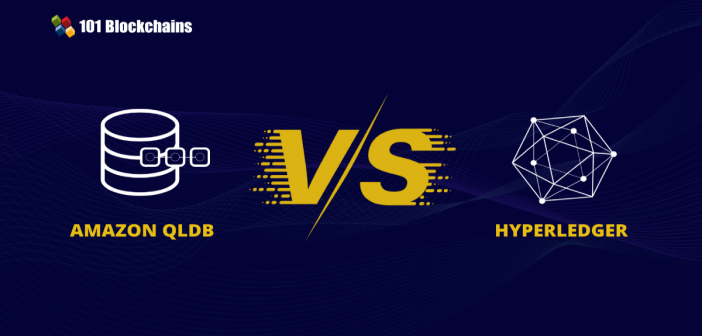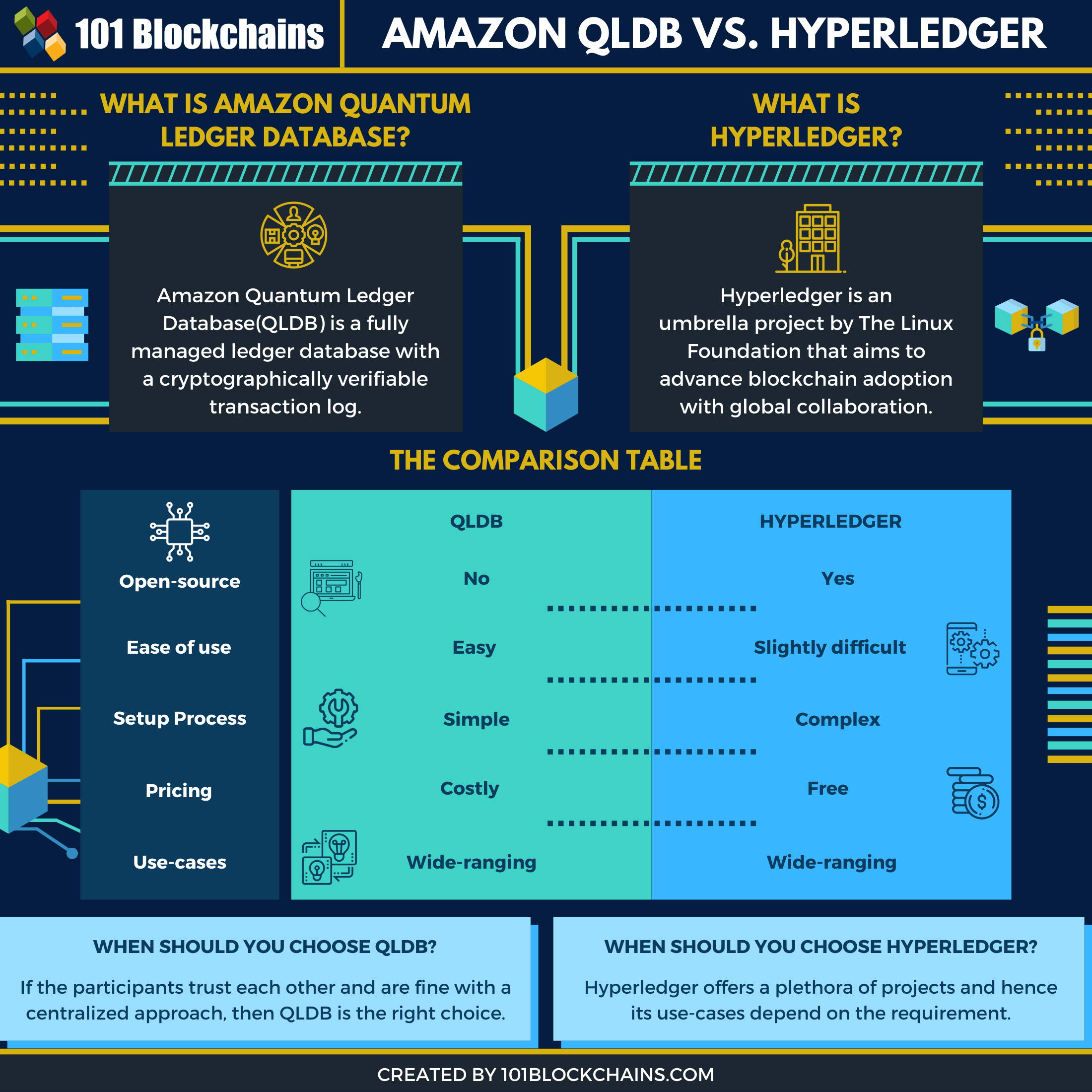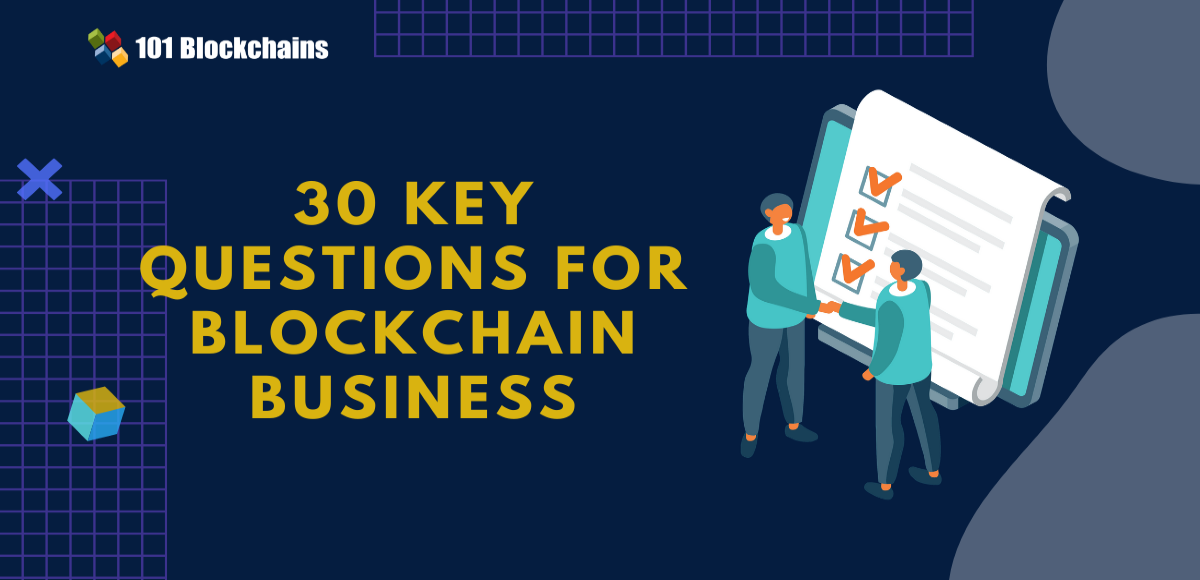Learn how blockchain truly works, master key definitions, and uncover what makes smart contracts so "smart." Dive into the fundamentals, gain valuable insights, and start your blockchain journey today!

- Opinions
101 Blockchains
- on April 12, 2021
QLDB vs Hyperledger: Key Differences
This article will focus on Amazon QLDB vs Hyperledger comparison and shed light on the differences between them.
Blockchain is growing rapidly. If you compare blockchain now and two or three years ago, you will find impressive growth to it. There have now been multiple blockchain-related solutions that aim to provide value to businesses, enterprises, organizations, and small startups who want to incorporate blockchain in their processes.
For instance, we have Hyperledger blockchain — an umbrella project by The Linux Foundation that aims to advance business blockchain adoption with global open-source collaboration. Its Hyperledger Greenhouse consists of projects including distributed ledgers, libraries, tools, and domain-specific.
Amazon Quantum Ledger Database (QLDB) is a fully managed ledger database that offers a verifiable transaction log that is cryptographically-enabled. It also offers key features such as immutable and transparent.
In comparison, we will take a look at different parameters and learn the difference between them. The focus is not to find who is the best but to see how each one works. If you are a business that is trying to figure out which technology is best for you, then read on!
Before we go to the actual comparison, let’s get familiar with QLDB and Hyperledger.
Build your identity as a certified blockchain expert with 101 Blockchains’ Blockchain Certifications designed to provide enhanced career prospects.
What is Amazon Quantum Ledger Database (QLDB)?
Amazon QLDB is a new blockchain-based solution that is released by Amazon in September 2019. They want to offer a fully managed ledger database. The database will offer key features such as a cryptographically verifiable transaction log. It also offers other blockchain-based features such as immutable and transparency.
It is also different from the other blockchain-based solution as it is controlled by a centralized authority. With it, you can create a database where all the transaction changes can be tracked, along with its history. To protect the changes, each of these changes to the data is cryptographically verified using hash data.
To get a better understanding, let’s take an example. If you are running a business where it is common for finance activities to happen, you would take advantage of the QLDB to store the data in a ledger. The ledger basically offers historical data storage with the ability to be integrated into any business process. You can also learn a lot from Amazon QLDB tutorial as well. In most cases, Amazon QLDB tutorial will show you how you can use this technology through simple iterations.
Please include attribution to 101blockchains.com with this graphic. <a href='https://101blockchains.com/blockchain-infographics/'> <img src='https://101blockchains.com/wp-content/uploads/2020/04/Amazon-QLDB-vs-Hyperledger.png' alt='QLDB vs Hyperledger='0' /> </a>
Hyperledger
Hyperledger is an open-source umbrella blockchain project managed by The Linux Foundation. It consists of distributed ledgers, tools, libraries, and domain-specific projects. It is a community-driven project with an aim to provide businesses the means to adopt blockchain and implement it in their processes. One of the famous Hyperledger projects includes Hyperledger Fabric. It’s widely popular among enterprises.
On the other hand, Hyperledger Sawtooth is also a rising star within their ecosystem. We have already covered Hyperledger in detail, and if you want to know more about it, then we recommend reading about them in the list below.
Excited to learn the basic and advanced concepts of Hyperledger Fabric? Enroll Now in Getting Started with Hyperledger Fabric Course
AWS QLDB vs Hyperledger
With the introduction of Hyperledger and QLDB databases done, it is now the time to go into the comparison. In comparison, we will try to compare them from certain categories. These categories will help you understand their limitations and opportunities that both of them carry.
Let’s list the categories on which we are going to compare them
- Open-source
- Use-cases (Requirements)
- Ease of use
- Ease of setup
- Support quality
- Ideal for
- Pricing
Open-source
Right now, the whole industry is moving towards open source. And, why not? There are many benefits of open source. The Linux Foundation is known for its open-source blockchain projects. They have successfully managed Linux operating systems, to say the least.
If you take both QLDB and Hyperledger into account, then you will find that only the Hyperledger project is open-source — after all, it is managed by the open-source community. The Linux Foundation is at the core of the action here. They want to improve the business adoption of blockchain and take the community’s approach in doing so.
So, how do they really do it? They have their Technical Steering Committee to look after the contributions. Each TSC consists of 11 elected members that take decisions to steer the technical direction for Hyperledger.
If you take Amazon’s QLDB, then you will see a closed-source approach. It is not bad or regressive in any way. It is just how Amazon wanted its product to be. They are a big company and have talented developers who can provide cutting-edge technology to consumers.
However, if you see the whole picture, Hyperledger is the winner here. They are focused on providing the community with options that keep evolving. There are other benefits of blockchain open-source projects, including cost-effectiveness, flexibility, agility, speed, less maintenance cost, and so on!
Use Cases
In this section, we are going to focus on the use-cases. Each of the technology has its own enterprise blockchain use cases. These use cases let you gauge the capacity of each technology. Let’s start with QLDB.
QLDB is versatile in its approach. It offers a wide-range of use-cases that range from finance, manufacturing, insurance, HR, Payroll, supply chain, and retail.
If you take finance as an example, QLDB can act as the ledger that stores all the transactions. The financial institutes can use the ledger to store critical information in a centralized approach, such as keeping track of the loans, bank accounts, credit and debit transactions. As a business, you can decide to include QLDB with your existing systems and enjoy the benefits of a ledger-powered database.
With benefits such as immutability, transparency, and scalability, a business cannot go wrong with the choice.
For Hyperledger, we have a completely different story here. It has a huge greenhouse associated with it which includes distributed ledgers, libraries, tools, and domain-specific. All these projects have huge use-cases associated with them. Clearly, it has more use-cases than QLDB. The top five use-cases for Hyperledger include the following
- Blockchain for supply chain management
- Blockchain for education and training
- Smart Energy Management
- Blockchain Trade Finance
- Streamlined Supply Chains
Here’s a list of Hyperledger use cases and case studies that you can check out to learn more about them.
Ease of Use
When it comes to ease-of-use, there is no doubt Amazon QLDB offers a much better ease-of-use. It offers familiar database capabilities and also supports PartiQL out-of-the-box. More so, it is an SQL-compatible query language that is open source and supports structures and data types. It offers an easy way to access data using SQL operations. Moreover, QLDB also supports the document-oriented data model. It enables a flexible way to store and access data. As a business, you can easily store semi-structured and structured data. Finally, QLDB is ACID-compliant and serialized.
Hyperledger, on the other hand, doesn’t offer the same level of ease-of-use. There are many ways you can take a look at it. Hyperledger offers full-fledged solutions for the business, which also includes distributed ledgers that can be built from scratch and implemented. Take Hyperledger Fabric, for example, as it offers a way to build a powerful blockchain solution for a business. That’s not ease-of-use at all! To work with these solutions, someone needs to be a technical person. This is a very important point in Amazon QLDB vs Hyperledger.
Ease of Setup
The ease of setup is our next category. As usual, QLDB is easy to set up, thanks to Amazon. They provide a QLDB driver that needs to be downloaded, installed, and configured to connect the application to a QLDB.
Hyperledger setups are not easy! They require a series of steps for the setup to complete. For each of the projects under the Hyperledger greenhouse, you can find the documentation for each. However, you can check out Hyperledger tutorial to better understand how you can use it.
Support Quality
Open-source projects tend to be a bit complex when it comes to providing support. If you go to any of the Hyperledger support pages (if they have any), you will get links to chat rooms, StackOverflow, community calls, and another way of communicating with other members utilizing the technology.
For Amazon QLDB, there is a completely different story. It is a premium solution that comes with its own support. So, if you get into any problem, you can take advantage of their support staff.
Pricing
QLDB is a paid service where the user needs to pay. The payment model used here is to pay as you use, and it has no minimum fees associated with it. Any decent application using QLDB can take anywhere between $50 to $100 per month. That’s affordable for many businesses out there that require a ledger-based database.
Hyperledger, on the other hand, has no pricing associated with it as it is open-source. Here, it is hard to find the winner as many businesses would want to pay for ease-of-use, support, and ease-of-setup. That’s why we settle for a tie.
This leads us to another point in Amazon QLDB vs Hyperledger
Want to understand the basics of AWS, AWS services, and AWS Blockchain? Enroll Now: Getting Started with AWS Blockchain as a Service (BaaS)
Does Amazon QLBD Challenge Permissioned Blockchain?
If you take Hyperledger into account, then you will find that it offers a good collection of permissioned blockchain solutions. Comparing QLDB to a full-fledged permissioned blockchain can be a bit too much. However, there are already many experts who are comparing QLDB to a permissioned blockchain.
The premise of comparison is whether QLDB challenges the notion of permissioned blockchain and can it replace it? Let’s explore below.
According to Gartner, there are four common denominators in consortium blockchain projects and promising multi-company. They include the following –
- Most consortia participants need a distributed ledger so that every participant within their network can access a single source of truth.
- Once the data is written to a ledger, it cannot be updated or deleted, making the data immutable.
- To create a verifiable audit trail, cryptography needs to be used so that the use-case can be satisfied.
- Lastly, any blockchain consortia should incentivize the various participants and offer them value for participating in the blockchain.
Out of all the four common denominators, two of them are satisfied by QLDB — which are 2nd and 3rd points. This means that QLDB offers a unique approach to providing companies a way to include blockchain-based features to their traditional legacy technologies. QLDB is only applicable where there is trust in the system and participants are fine with a centralized authority.
However, there is a limitation with QLDB as it relies on AWS blockchain. Also, its impact is yet to be gauged outside of the AWS use-cases. We can conclude that QLDB doesn’t directly challenge the permissioned network but will help it instead to reach new businesses. We can also term QLDB as a Quasi-Blockchain solution.
Curious about AWS blockchain? Here’s a comprehensive guide on AWS blockchain that will help you understand the concepts better.
When Should You Choose Amazon Quantum Ledger Database QLDB?
If the participants trust each other and are fine with a centralized approach, then QLDB is the right choice.
When Should You Choose Hyperledger?
Hyperledger offers a plethora of projects, and hence its use-cases depend on the requirement. However, all the projects are decentralized, and hence a business should only choose Hyperledger if they are looking for a decentralized approach. We hope you got an idea of AWS QLDB vs Hyperledger.
Conclusion
This leads us to the end of our AWS QLDB vs Hyperledger article. There is no doubt that both of them offer a unique solution to different audience types. Therefore, it’s easy to collude that both technologies are performing well in their respective fields.
Companies that want to go decentralized or wants to utilize the power of blockchain should go for Hyperledger. But if they want more centralized control, it’s best to stick with QLDB. If you are still curious about Hyperledger, then we recommend enrolling in our getting started with Hyperledger Fabric course, which will cover everything you need.
*Disclaimer: The article should not be taken as, and is not intended to provide any investment advice. Claims made in this article do not constitute investment advice and should not be taken as such. 101 Blockchains shall not be responsible for any loss sustained by any person who relies on this article. Do your own research!




![Future of Blockchain: Predictions for 2022 [UPDATED] future of blockchain predictions](https://101blockchains.com/wp-content/uploads/2020/12/future-of-blockchain-predictions.png)

